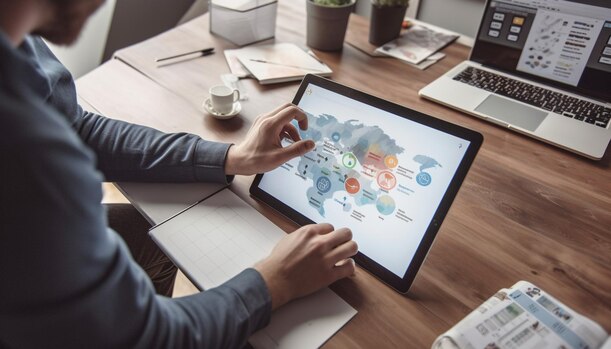Introduction:
The way we dine and consume food has undergone a dramatic transition in the fast-paced and interconnected world of the 21st century. With the introduction of smartphones and high-speed internet, a new sector has emerged: food delivery applications. These platforms have not only changed consumer behavior, but have also affected the global dynamics of the food and beverage business. As we approach 2024, it seems certain that food delivery apps will continue to develop at an unparalleled rate, impacting how people eat, establishments operate, and economies prosper.
A Brief Overview of Food Delivery App Evolution
Food delivery has its origins in the conventional idea of ordering food over the phone. The major game changer, however, was the incorporation of mobile applications into this process. Grubhub and Seamless were early pioneers who laid the groundwork for what would become a worldwide phenomenon. As technology improved, so did these applications, which now include real-time tracking, a variety of payment choices, and user-friendly interfaces. This innovation has considerably contributed to the global popularity of food delivery applications. In the realm of digital solutions, the demand for food delivery app development solutions has emerged as a pivotal component, shaping the evolution of this industry.
Market Trends and Key Players
The global food delivery app market is defined by intense competition and rapid innovation. By 2024, a few key actors will dominate the landscape. Uber Eats, DoorDash, Just Eat Takeaway.com, and Zomato have expanded their global footprint through mergers and acquisitions in order to enhance their market positions. Local actors are also crucial in catering to area tastes and demands. The market’s competitive character has resulted in continuous changes that benefit both customers and the foodservice sector.
Technological Progress and User Experience
The persistent pursuit of technology breakthroughs is one of the driving causes behind the success of food delivery applications. To improve user experiences, optimize delivery routes, and customize suggestions, artificial intelligence, machine learning, and data analytics are being used. By 2024, these technologies will have been seamlessly integrated, making the ordering process more efficient and pleasurable for customers. Chatbots and virtual assistants help to further simplify communication by giving rapid support and quickly addressing difficulties.
The Convenience Factor in Changing Consumer Behavior
The growing dependence on food delivery apps reflects a shift in consumer behavior throughout the world. People’s demand for convenience, along with their hectic schedules, has driven many to choose the simplicity of ordering food with a few clicks on their cellphones. The COVID-19 pandemic intensified this tendency, with lockdowns and safety concerns fueling an increase in demand for contactless food delivery. The convenience factor remains a key motivator in 2024, impacting not only metropolitan areas but also suburban and rural places.
Globalization and Culinary Diversity
Food delivery apps have become a portal to culinary exploration, introducing customers to a wide variety of cuisines. People may now eat real cuisines from throughout the world without leaving their homes, demonstrating the globalization of preferences. This tendency has generated a gastronomic renaissance, causing restaurants to innovate and broaden their products in order to cater to a more experimental and demanding consumer base.
Restaurant Collaborations and Business Models
Collaborations between meal delivery applications and restaurants have become mutually beneficial, with both parties benefiting. Apps now have access to a greater variety of culinary alternatives, while establishments may reach a larger consumer base without spending much on delivery infrastructure. In 2024, subscription models, loyalty programs, and exclusive alliances are common, encouraging long-term connections between platforms and their restaurant partners.
Challenges and Controversies
Despite its extraordinary rise, the meal delivery app sector is not without its hurdles and controversies. Labor rights, appropriate remuneration for delivery workers, and the impact of hefty commission fees on small firms have all aroused controversy. Regulatory scrutiny and legal challenges are additional obstacles to the industry’s unfettered growth. Stakeholders are struggling with these problems in 2024, sparking talks on ethical corporate practices and long-term strategies.
Environmental Sustainability: A Growing Imperative
Food delivery’s environmental effect, notably in terms of packaging waste and carbon emissions, has gained importance in recent years. Food delivery apps are under growing pressure to embrace sustainable methods as consumers become more ecologically concerned. In 2024, we will see efforts such as eco-friendly packaging, electric delivery trucks, and carbon offset schemes, indicating a concerted attempt to reduce the industry’s environmental imprint.
Innovations and Projections for the Future
Looking ahead, continual innovation is projected to boost the worldwide expansion of food delivery applications in 2024. On the horizon are the incorporation of augmented reality for virtual menu experiences, the usage of blockchain for transparent supply chains, and the investigation of drone and autonomous vehicle delivery. Collaboration with smart kitchens and ghost kitchens is projected to transform the way food is cooked and served as the industry advances, further disrupting the traditional restaurant model.
Post-Pandemic Reality
The COVID-19 epidemic changed the food delivery industry’s environment, accelerating changes that were already in action. While lockdowns and social distancing restrictions have been lifted in many parts of the world, the pandemic’s impact remains. Food delivery applications will continue to play an important part in providing a secure and quick eating alternative for individuals who are wary about in-person dining in 2024. The lessons learnt during the pandemic, such as the significance of sanitation, contactless transactions, and dependable delivery services, have been embedded in customer expectations, establishing food delivery apps’ role in the post-pandemic period.
Catering to Individual Tastes and Preferences
Food delivery apps are increasingly understanding the necessity of hyperlocalization as they grow abroad. Understanding and responding to regional tastes, nutritional habits, and cultural subtleties has become critical to success. By 2024, we expect apps to engage in local relationships, include regional specialties into their products, and adjust marketing methods to appeal to a wide range of populations. This hyperlocal strategy not only improves consumer happiness but also increases the app’s relationship to the areas it serves.
Bridging Accessibility Gaps Through Inclusive Access
The expansion of food delivery applications in 2024 will not be restricted to metropolitan areas. Efforts are being undertaken to eliminate accessibility gaps in suburban and rural areas, so that individuals in all locations may benefit from these services. To tackle logistical issues, innovations such as satellite kitchens and decentralized distribution hubs are being investigated. Furthermore, attempts to address price problems, such as reduced meal programs and collaborations with local NGOs, help to make food delivery more inclusive and accessible to a broader audience.
Concerns about data privacy and security
With the increased dependence on technology and the acquisition of massive amounts of consumer data, the problem of data privacy and security has risen to the fore. Food delivery applications will face increased scrutiny in 2024 for the security of customer information, order history, and payment data. Striking a balance between offering tailored services and protecting client privacy is a difficult task that the sector must negotiate. Stronger data protection methods, more clear privacy rules, and proactive communication about security procedures are all becoming critical components of ethical company activity.
Cloud Kitchens and Virtual Restaurants
Virtual restaurants and cloud kitchens are altering the traditional restaurant paradigm, and their importance is predicted to increase in 2024. These businesses only accept online orders and generally do not have a physical location. Food delivery apps are profiting on this trend by collaborating with virtual eateries to increase their menu offerings without the requirement for a physical location. Virtual restaurants’ agility and cost-effectiveness coincide with the growing dynamics of the food delivery ecosystem, providing customers with more options and opening up new potential for culinary entrepreneurs.
Menus using Augmented Reality and Interactive Experiences
Augmented reality (AR) integration into food delivery applications is improving the customer experience in unique ways. Consumers will be able to digitally explore menu items with AR applications in 2024, viewing meals in real-time before making an order. This dynamic and immersive approach not only makes the ordering experience more enjoyable, but it also allows consumers to make better educated decisions. AR technology’s application in food delivery is anticipated to grow as it advances, giving chances for creative marketing and increased consumer involvement.
Food Delivery Ecosystem Corporate Social Responsibility
Food delivery apps are adding corporate social responsibility (CSR) activities into their business models in response to rising awareness of social and environmental challenges. Community participation, nonprofit alliances, and sustainability programs are examples of such projects. In 2024, customers will be more concerned with the values and ethics of the firms they support, and meal delivery apps will respond by partnering with causes that are important to their user base. This not only improves corporate image, but it also has a good social impact by instilling a feeling of shared responsibility in the communities they serve.
Smart Cities and Urban Planning Collaboration
Food delivery app growth is interwoven with the larger development of smart cities and urban planning. Collaboration between these platforms and local authorities is increasing, with an emphasis on optimizing traffic flow, decreasing congestion, and enhancing overall logistical efficiency. In 2024, we will see trial programs in which food delivery apps actively participate in urban planning talks, offering data and insights to construct more sustainable and efficient cityscapes. This partnership intends to overcome the issues faced by the growing demand for food delivery in densely populated metropolitan regions.
Gig Workers’ Education and Training
The dependence on independent contractors for food delivery in the gig economy has spurred a reevaluation of the education and training offered to these workers. Food delivery apps will spend more in programs that improve the abilities of its gig workers in 2024, ranging from efficient navigation and customer service to food safety procedures. This not only enhances service quality but also helps to gig workers’ professional growth and job happiness, building a more positive and sustainable gig economy.
Navigating a Difficult Environment
As the food delivery app sector grows, the regulatory environment will change. Governments all across the world are debating or enacting legislation to address a variety of issues, including worker rights, fair competition, and consumer protection. Food delivery apps are actively collaborating with regulatory organizations in 2024 to establish regulations that balance innovation and good business practices. The ability to strike the correct balance between sector expansion and protecting the interests of all stakeholders is critical for the long-term development of the global food delivery ecosystem.
Conclusion:
The global expansion of food delivery apps in 2024 is a dynamic that is always developing to satisfy the changing requirements and expectations of customers, eateries, and society as a whole. The sector is negotiating a complex web of problems and possibilities, ranging from technology advancements and environmental sustainability to social responsibility and equitable access. The significance of food delivery apps, along with the evolving role of food delivery app builders, in altering how we eat, taste global flavors, and connect with our communities is certain to stay crucial as the culinary future unfolds. The ability of the culinary sector to adapt, innovate responsibly, and solve current issues will determine its long-term effect on the global culinary environment.



